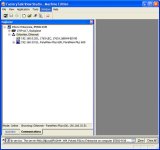lostcontrol
Lifetime Supporting Member
Hi,
We have a site that has a CLX-L61 with dual ETN's, & 2x L32E's, + a 2x PV+'s.
The CLX ETN's have IP's on 10.1.17.xx & 10.1.18.xx. One of the L32E's is on 10.1.17.xx, whilst the other is in 10.1.18.xx.
The 10.1.18.xx has 2 point IO drops also on 10.1.18.xx, whilst the 10.1.17.xx has VSD's, that are on 10.1.18.xx.
The PV+'s are on 10.1.17.xx.
What I want to be able to do, is to access the L32E on the 10.1.18.xx network, from the PV+'s, on 10.1.17.xx.
Is this easy enough to accomplish? Do I just need to open the subnet mask up to allow comms to 10.1.18.xx?
We have a site that has a CLX-L61 with dual ETN's, & 2x L32E's, + a 2x PV+'s.
The CLX ETN's have IP's on 10.1.17.xx & 10.1.18.xx. One of the L32E's is on 10.1.17.xx, whilst the other is in 10.1.18.xx.
The 10.1.18.xx has 2 point IO drops also on 10.1.18.xx, whilst the 10.1.17.xx has VSD's, that are on 10.1.18.xx.
The PV+'s are on 10.1.17.xx.
What I want to be able to do, is to access the L32E on the 10.1.18.xx network, from the PV+'s, on 10.1.17.xx.
Is this easy enough to accomplish? Do I just need to open the subnet mask up to allow comms to 10.1.18.xx?






